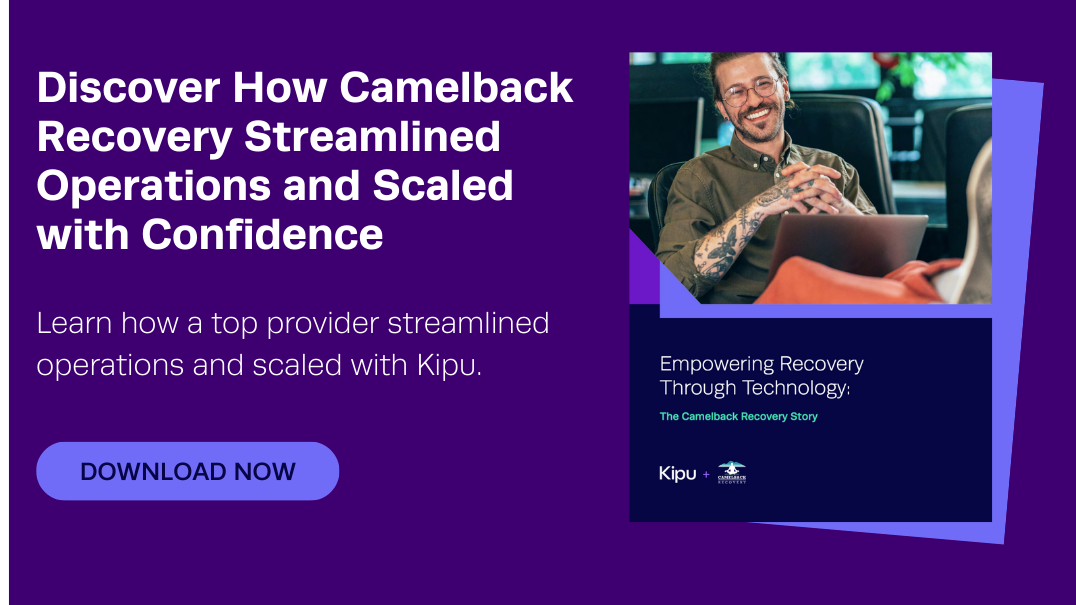AI in Behavioral Health: 6 Practical Insights from the Frontlines at Banyan Treatment Centers

A new chapter is opening in behavioral health.
In every corner of behavioral health, new possibilities are taking shape. Leaders are beginning to see how fresh tools can help reclaim time, restore purpose, and forge deeper connections with patients or clients. AI is no longer some distant concept, but an active partner in helping clinicians reconnect with their work and deliver better patient care. That spirit of possibility was on full display during a recent Kipu webinar featuring Banyan Treatment Centers and their journey with AI.
Banyan’s journey is living proof of what’s possible when AI is used effectively in practice. Their experience demonstrates how new tools can strengthen compliance, improve efficiency, and inspire teams, while keeping patient care at the center. Here are 6 practical insights from the webinar that show exactly how that transformation can unfold. These are distant stretch goals–they’re things you can implement today.
1. Start with the Why: Paperwork Is Stealing Purpose
Dr. Cara Bishop, VP of Clinical Services at Banyan, shared a reality that you’re probably familiar with: clinicians aren’t burning out because of patient care, they’re burning out because of paperwork. At one site, four therapists resigned in a single week.
Documentation requirements were airtight from a regulatory standpoint, but at the expense of human connection. The disconnect was clear: “Paperwork was the job, and not the one that clinicians came here to do,” Cara said.
For executives, the lesson is simple but critical: the first step toward meaningful AI adoption is understanding where your organization’s “purpose gap” lies. Where are your clinicians being pulled away from what they came to this field to do?
2. Integration Matters More Than Hype
Plenty of vendors promise to “fix” documentation. But as Bishop explained, most of them required costly, time-consuming, and complicated integrations with existing EMRs. That barrier stopped progress before it started. The turning point came when Banyan adopted Kipu AI, which was already embedded in their EMR. The tool didn’t add a new layer of work, it streamlined the workflows clinicians were already in.
For leaders, this is a key takeaway: successful AI adoption isn’t about finding the flashiest tool, it’s about embedding intelligence into existing workflows. Integration isn’t a feature—it’s the foundation.
3. Time Savings Are Real—and Transformative
Early pilots showed staggering results. A biopsychosocial assessment that once took an hour now took 15–30 minutes. AMA notes dropped from 30 minutes to two. Standard progress notes were cut in half.
Those numbers tell one story. The ripple effects tell another. Clinicians found themselves with “pajama time” reclaimed. Supervisors had clearer visibility into training needs, turnover risk decreased almost immediately, and morale lifted as staff saw a “light at the end of the tunnel.”
This isn’t just about efficiency. For executives, it’s about retention, recruitment, and building a culture where clinicians can do the work they love.
4. Compliance and Quality Are Strengthened, Not Sacrificed
Skepticism around AI is natural: Will this reduce quality? Will compliance take a hit? Banyan’s experience shows the opposite. They ran a comparison study between an AI-supported clinician and one without AI. The AI-assisted assessment was completed in 39 minutes and scored 100% on compliance. The non-AI version took 78 minutes and scored 93%.
For leaders, this reframes AI from a risk to a safeguard. Done right, AI reduces hidden costs like rework, audit failures, and denied claims—all while strengthening the integrity of care.
5. Change Management Is Just as Important as the Tech
Of course, there were fears. Clinicians asked: “Are you replacing me?” The answer was no. Banyan embraced those concerns as part of the rollout, framing AI as augmentation, not replacement.
As EVP of Product Sally Abu-Mustafa put it, success comes when respected leaders champion the change, engage teams in feedback, and measure results in terms that matter: time saved, claims paid, compliance improved. Leaders considering AI must approach it as both a technology and a cultural shift. The tool is only as effective as the trust you build around it.
6. Patient Impact Is the End Goal
Perhaps the most important lesson is the simplest: the point isn’t to save time for its own sake. It’s to give that time back to patients. With less administrative burden, Banyan’s clinicians are reporting stronger therapeutic engagement, better recall for treatment planning, and even a renewed sense of purpose in their roles. One participant in the webinar put it best: “I’ve fallen in love with my job again.”
For executives weighing whether AI is worth the effort, that’s the ultimate ROI: not just efficiency or compliance, but a better patient experience—and a workforce that still loves the work.
Moving Forward: Redefining Clinical Excellence
The lesson from Banyan isn’t that AI solves everything overnight. It’s that when applied thoughtfully—embedded in workflows, supported by leadership, and measured with clear outcomes—it can redefine what clinical excellence looks like.
Behavioral health is on the cusp of an exciting new era. But the right tools can shift the narrative from burnout and backlog to time reclaimed and purpose restored. AI isn’t replacing clinicians. It’s freeing them to do what they do best: care for patients.
Missed the webinar?
You can watch the full discussion with Banyan and Kipu leaders here:
Want to see how Kipu can help your organization build resilience, scalability, and compliance into your operations?
Recent Posts
Rely on Kipu to keep you ahead of change.
Subscribe to Kipu for behavioral health news, updates, community celebration, and product announcements.


